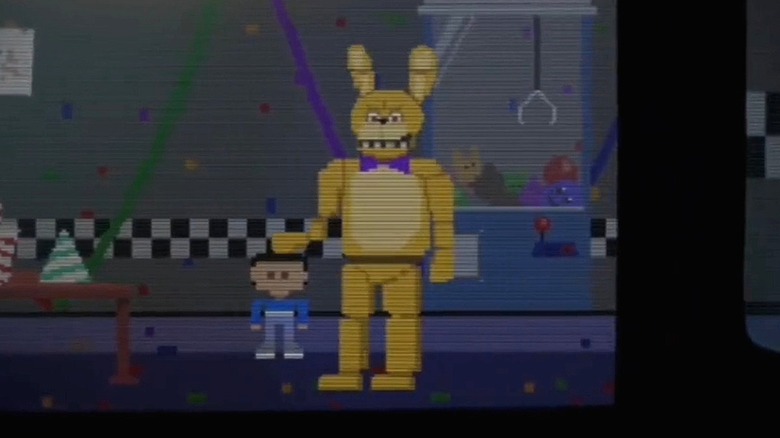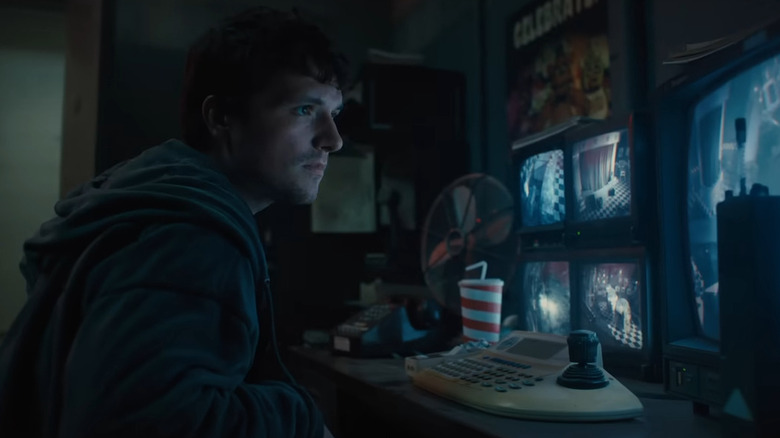FNAF's Pixel Art Opening Credits Explained
Contains spoilers for "Five Nights at Freddy's"
Blumhouse Productions changed a few things from the games when adapting "Five Nights at Freddy's" into a feature-length film. More accurately, Scott Cawthon — the creative mind behind the video game franchise — changed a few things because he held a position of power over Blumhouse's project not dissimilar to J.K. Rowling's position of power over Warner Bros.' adaptation of the Harry Potter series. The coolest result from Cawthon's inclusion is that the movie packs in as much visual detail with as many references to the source material as possible. And that's probably why the opening credit sequence is a pixel art fever dream.
The original games aren't stylistically pixelated, but the minigames are. For gamers, the term "minigame" generally refers to a game within the game that deviates from the core mechanics of the main title. Consider how players can enjoy a retro level of "Crash Bandicoot" in "Uncharted 4: A Thief's End." In "FNAF," the minigames are always pixelated (usually 16-bit) and replace the core mechanics of horror-themed resource management with simple platforming puzzles. Oh, and they're also almost exclusively how Cawthon reveals important exposition. Whether the minigame requires the player to gather balloons or to explore the pizzeria, every single one of them explains something dark and tragic and murder-y about the history of Freddy Fazzbear's Pizza.
But what makes the film's pixelated opening credits memorable for the gamers isn't that they're a graphically charged homage to Cawthon's minigames. It's that only the dedicated gamers will have ever even played the minigames because they are notoriously difficult to unlock.
FNAF's lore is locked behind hidden 16-bit minigames
The bulk of the gameplay in the Five Nights at Freddy's franchise revolves around a stationary security guard flipping through various camera feeds to track the child-possessed animatronic mascots and closing reinforced doors and vents whenever the aforementioned monstrosities get too close. Nowhere between the jumpscares and awkward phone calls from your sketchy boss do the games suggest that using the mouse cursor to click on random wall tiles or background drawings will unlock a variety of narratively relevant minigames. Sure, any Average Joe with access to a Wiki can find them now, but imagine trying to find them without a walkthrough tab open.
In "FNAF 3," the "Happiest Day" minigame is only accessible to those who know to open HALL (CAM 03) and double-click on the drawing of the Puppet on the right-hand wall. In later games, like "FANF 4," Cawthon lowers the bar to entry for these kinds of lore dumps by placing them as unavoidable interstitial content between levels. Other games in the series use a mixture of these two models, but the point remains the same — FNAF and pixelated minigames are functionally synonymous ideas. Without them in some capacity, would a FNAF film really be a FNAF film? No, and Blumhouse Productions makes the pixelated opening credits a diegetic sequence by loading the Pizzaria with arcade cabinets, guaranteeing it makes some sense to even the non-gaming audience. With such attention to detail, it's no wonder why "FNAF" scared up an incredible opening weekend.
Also, in true Cawthon fashion, the scant pixels reveal vital plot information like, hey, maybe don't trust the creepy golden bunny with an evil smile and a blood-crusted knife.

